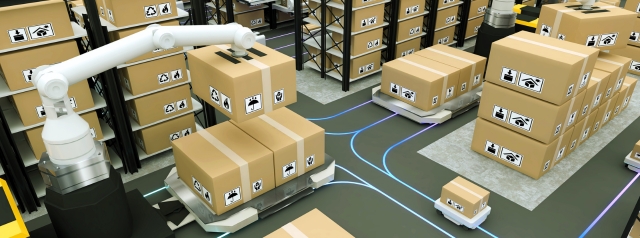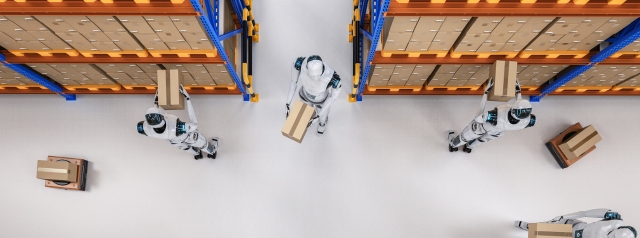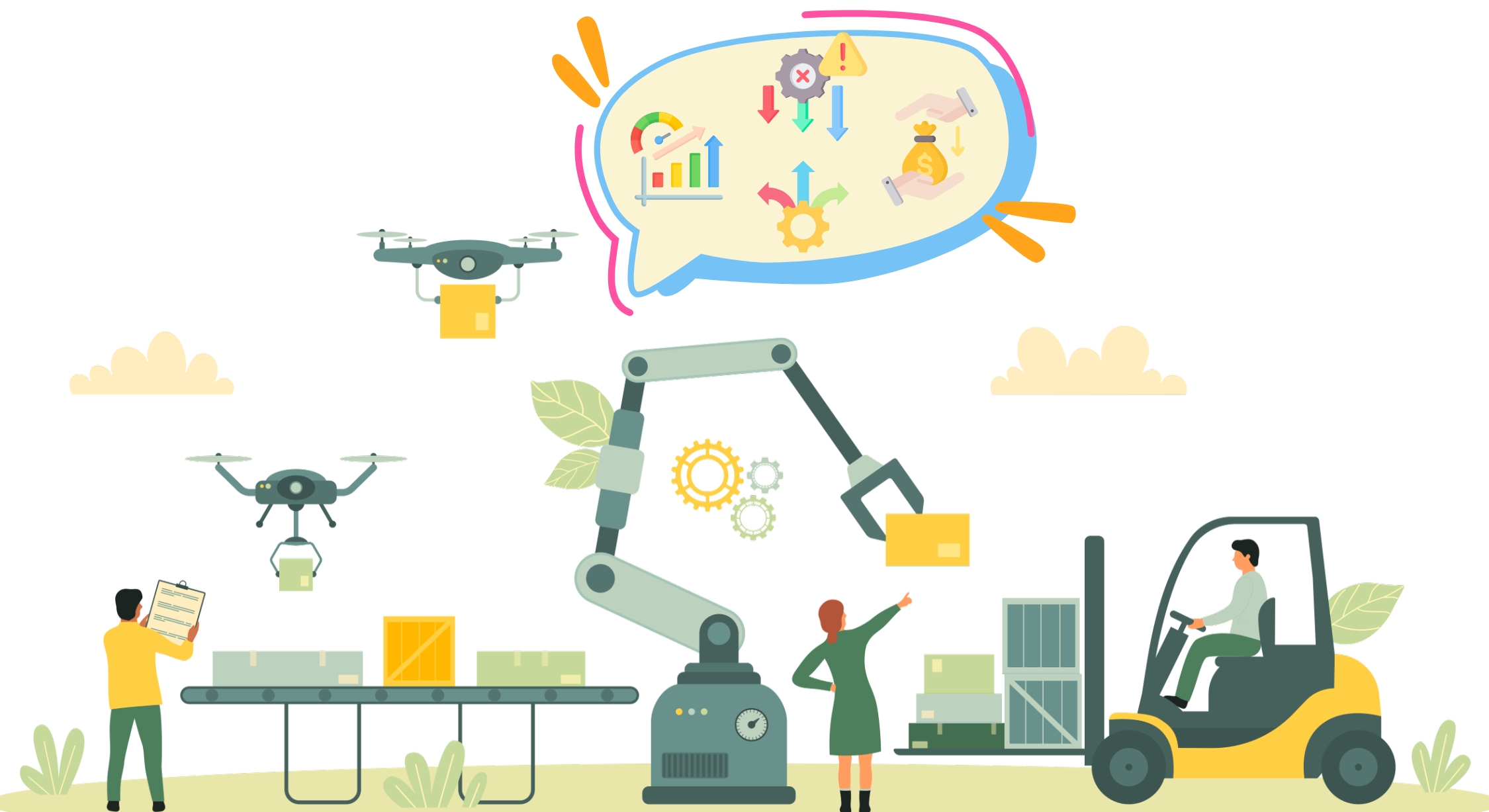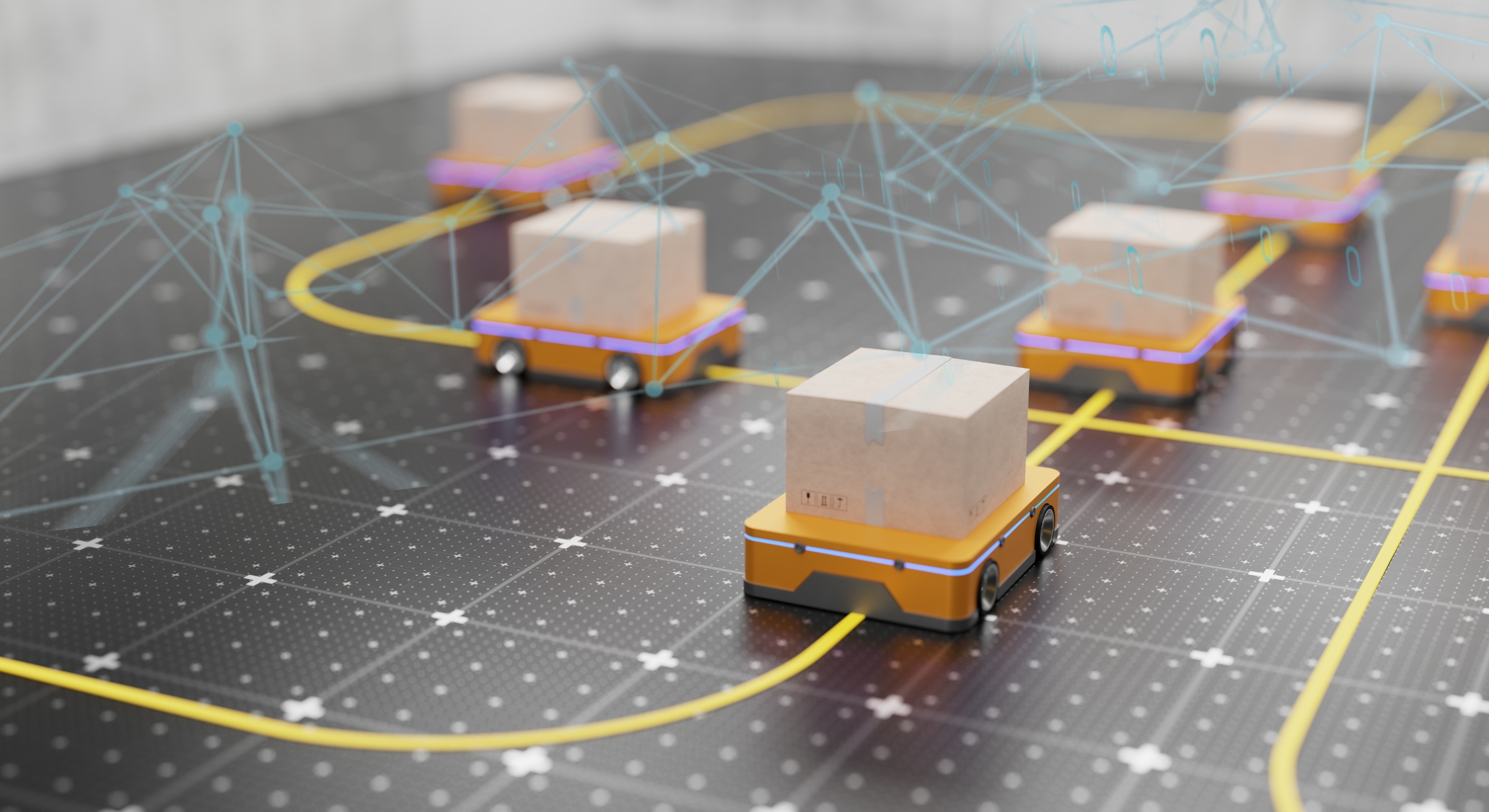Experion is reshaping warehouse operations with innovative AI-powered automation, streamlining processes and setting new standards for customer satisfaction in today’s evolving business environment. Over the years, warehouse automation has evolved from simple mechanized systems to fully automated, AI-driven solutions capable of transforming the entire supply chain. Initially focused on reducing manual labor and improving productivity, the field has now entered a new phase, driven by AI.
Why AI is the Game-Changer?
AI is transforming the traditional warehouse model by significantly enhancing efficiency, accuracy, and cost-effectiveness. Through intelligent data processing and advanced robotics, AI-driven automation systems can perform tasks faster than human workers while ensuring near-perfect accuracy. Machine learning algorithms continuously optimize routes for picking and packing, reducing the time and distance involved in manual processes. These innovations directly lead to lowered operational costs, fewer errors, and quicker delivery times, resulting in improved customer satisfaction.
The Role of AI in Warehouse Automation

AI plays a critical role in modern warehouse operations, enabling smarter decision-making, real-time analytics, and optimized workflow processes. With AI, warehouses can operate with minimal human intervention, leveraging machine learning to predict demand, adjust stock levels, and improve overall accuracy. In a global landscape where rapid delivery and fulfillment are becoming competitive necessities, AI-powered warehouses offer companies the ability to stay ahead of the curve by automating tasks that were once labor-intensive and prone to error.
AI-Driven Warehouse Operations
AI is revolutionizing warehouse operations through a set of key technologies that enable smarter, more responsive, and adaptable processes:
- Machine Learning (ML): ML enables warehouse systems to “learn” from data, improving decision-making over time. It can predict stock needs, adjust inventory in real-time, and optimize picking routes, ensuring that warehouses run as efficiently as possible.
- Computer Vision: Computer vision allows systems to visually interpret and process data from camera feeds, enabling real-time object recognition and monitoring. This is particularly valuable for automated quality checks, inventory management, and package sorting.
- Natural Language Processing (NLP): NLP empowers voice-assisted systems to interact with warehouse workers, improving communication and task management. Through voice commands, workers can retrieve data, get real-time updates on stock levels, and operate machines with minimal physical effort.
AI vs. Traditional Automation
When comparing AI-powered solutions to traditional automation, the advantages of AI become clear. Traditional warehouse automation relies on pre-programmed rules and repetitive mechanical tasks. While it offers improvements in speed and consistency, it lacks the flexibility and adaptability required to handle today’s complex supply chains.
AI-powered automation, on the other hand, uses advanced algorithms to not only perform tasks but also adapt to changing conditions. AI systems can learn from data, make predictive adjustments, and process vast amounts of information far beyond human capabilities. Unlike traditional systems, AI-driven warehouses can handle unexpected changes in demand, optimize resources in real-time, and continually improve through self-learning capabilities. This adaptability makes AI essential for any business looking to future-proof its warehouse operations.
Applications: Warehouse Automation AI

- Automated Inventory Management
AI enables real-time tracking and forecasting of inventory, ensuring that warehouses maintain optimal stock levels. Using machine learning algorithms, AI systems predict future demand based on historical data and market trends, helping warehouses avoid overstocking or running out of essential items. This real-time data flow also improves transparency and visibility across the supply chain, allowing managers to make data-driven decisions and avoid bottlenecks. - Optimized Order Picking and Packing
AI-powered robotic systems have revolutionized order picking and packing processes by offering unprecedented precision and speed. These robots, equipped with computer vision and advanced algorithms, can identify products, navigate the warehouse, and pick items faster than human workers, while minimizing errors. This not only increases throughput but also reduces the physical strain on human workers, enabling them to focus on higher-value tasks. - Autonomous Mobile Robots (AMRs)
AI plays a crucial role in enhancing the capabilities of Autonomous Mobile Robots (AMRs). These robots can navigate complex warehouse environments without human intervention, thanks to AI-driven sensors and real-time mapping technologies. They transport goods across the warehouse with precision and can avoid obstacles, improving both safety and efficiency. AI’s adaptability allows AMRs to learn and adjust their routes over time, optimizing operations in a dynamic environment. - Predictive Maintenance
AI-powered predictive maintenance systems can analyze equipment performance in real-time to forecast when a machine might fail or require servicing. By anticipating these breakdowns, AI helps warehouse operators schedule maintenance during non-peak hours, reducing downtime and extending the lifespan of machinery. This predictive approach lowers repair costs and minimizes disruptions, keeping warehouse operations running smoothly. - Warehouse Layout Optimization
AI is also instrumental in designing efficient warehouse layouts. Using advanced simulations, AI analyzes operational data to suggest layout changes that can optimize space usage, reduce walking distances for workers and robots, and speed up the flow of goods. This process not only improves efficiency but also ensures that the warehouse can adapt to changing demands, such as seasonal peaks or the introduction of new product lines. - Demand Forecasting
AI’s ability to analyze historical data and market conditions enables it to anticipate customer demand with remarkable accuracy. By using AI-driven demand forecasting, warehouses can adjust inventory levels to meet anticipated changes, ensuring they are neither understocked nor overstocked. This results in reduced waste, improved customer satisfaction, and more efficient use of resources. - Enhanced Security and Safety
AI-powered surveillance systems enhance warehouse security by monitoring activities in real-time and detecting potential security threats. Computer vision and machine learning technologies can identify suspicious behavior or unauthorized access, triggering alerts and preventing theft. Additionally, AI systems help prevent accidents by detecting unsafe working conditions, such as misplaced objects or machinery malfunctions, further improving workplace safety.
Key Metrics for Measuring AI Impact in Warehousing
Productivity Metrics
AI allows for precise tracking of productivity within the warehouse. By monitoring the efficiency of robotic systems, the speed of order fulfillment, and the flow of goods, AI provides data-driven insights that help managers identify areas for improvement. Metrics such as orders processed per hour, picking speed, and overall warehouse throughput can be significantly improved through AI automation.
Accuracy Metrics
Measuring error rates before and after AI implementation provides valuable insights into the accuracy improvements brought about by AI. AI-driven systems, particularly in inventory management and order picking, drastically reduce human errors. With AI, warehouses can track how many orders are accurately fulfilled, how often stock levels are correct, and how frequently products are correctly identified and packed.
Cost Reduction Metrics
Cost savings attributed to AI automation can be measured by analyzing reductions in labor costs, downtime, and maintenance expenses. Predictive maintenance, optimized workflows, and reduced errors all contribute to significant operational cost savings. These metrics help in calculating the return on investment (ROI) for AI implementation and demonstrate how automation can improve the bottom line.
Customer Satisfaction Metrics
AI-driven automation directly impacts customer satisfaction by improving order accuracy, reducing delivery times, and ensuring product availability. Metrics such as on-time delivery rates, customer feedback scores, and retention rates can help measure how AI is improving customer experiences. A faster, more reliable warehouse operation leads to increased customer loyalty and long-term business success.
At Experion, we prioritize our clients by diligently tracking key performance metrics such as productivity, accuracy, cost savings, and customer satisfaction, ensuring that our AI-driven warehouse automation solutions consistently deliver exceptional value and measurable results.
Benefits of Warehouse Automation AI

Increased Efficiency and Productivity
One of the most significant advantages of AI in warehouse automation is the dramatic increase in efficiency and productivity. AI-driven systems can process tasks much faster than human workers, leading to quicker order fulfillment, reduced lead times, and higher throughput. Additionally, AI helps reduce labor costs by automating repetitive and labor-intensive tasks, allowing businesses to allocate human resources to more strategic activities.
Enhanced Accuracy and Reduced Errors
AI minimizes human errors by utilizing machine learning, computer vision, and predictive analytics to ensure that tasks such as inventory management, order picking, and packing are performed with near-perfect precision. AI systems can cross-check orders and stock levels in real time, ensuring that mistakes in shipping or inventory counts are significantly reduced, resulting in more accurate and reliable operations.
Scalability and Flexibility
AI-powered warehouse automation systems are inherently scalable and flexible, allowing businesses to adapt to changing needs without overhauling their entire infrastructure. Whether dealing with seasonal demand spikes or expanding product lines, AI systems can seamlessly scale up or down based on real-time requirements, optimizing resource allocation and ensuring operational continuity.
Cost Savings
While AI integration requires an initial investment, the long-term cost benefits are significant. AI reduces labor costs, minimizes errors, and optimizes energy consumption, leading to substantial savings over time. Predictive maintenance also helps reduce unexpected equipment breakdowns, further lowering costs associated with downtime and repairs. With these efficiencies, businesses can quickly recoup their investment and continue to save money in the long run.
Challenges and Considerations
Integration with Existing Systems
One of the primary challenges in implementing AI in warehouse automation is the integration with existing legacy systems. Many warehouses still rely on traditional automation or manual processes, making it difficult to merge AI technologies seamlessly. The process often requires a comprehensive review of current systems, infrastructure upgrades, and extensive training for staff to ensure smooth operation between AI and non-AI systems.
Data Management and Privacy
AI systems rely heavily on data to function, and with that comes concerns around data management and privacy. Warehouses must ensure that sensitive data, such as customer information and operational metrics, is securely stored and protected from breaches. Implementing robust cybersecurity measures and adhering to industry regulations is crucial to maintaining trust and avoiding legal liabilities when using AI-powered automation.
Initial Investment and ROI
The initial investment in AI warehouse automation can be a considerable expense, particularly for small and mid-sized businesses. The cost of purchasing AI-powered equipment, upgrading existing infrastructure, and training staff may present a significant barrier to entry. However, the long-term benefits, such as increased efficiency, reduced errors, and cost savings, must be weighed against this upfront expense to evaluate the return on investment (ROI). A detailed cost-benefit analysis is essential to ensure that AI implementation will deliver the expected financial rewards over time.
The Future of AI in Warehouse Automation

Emerging Trends
As AI continues to push the boundaries of what is possible in warehouse automation, several emerging technologies are poised to dramatically reshape the industry. These trends reflect advancements in connectivity, computing power, and AI’s ability to process large datasets in real-time, bringing about innovations that will further improve warehouse efficiency, safety, and scalability.
- 5G Connectivity: The advent of 5G technology is set to revolutionize the speed and responsiveness of warehouse operations. With ultra-fast data transmission and low latency, 5G networks will allow AI-driven robots, sensors, and machines to communicate and make decisions in real-time. This improved connectivity will enhance the precision of automated systems, enable real-time monitoring and coordination of warehouse activities, and support the simultaneous operation of thousands of connected devices without any lag, drastically improving efficiency.
- Edge Computing: Edge computing refers to processing data closer to the source—such as AI-enabled robots, drones, or automated vehicles—rather than relying on centralized cloud servers. This reduces latency and allows for faster decision-making, which is critical in time-sensitive warehouse operations. With edge computing, AI algorithms can rapidly process data on-site, allowing systems to adapt to changes in the warehouse environment in real time. This is particularly important in large-scale operations where split-second decisions can lead to massive productivity gains.
- Collaborative Robots (Cobots): While traditional robots have already proven effective in automating tasks such as picking, packing, and sorting, the next evolution involves collaborative robots, or cobots. These robots are designed to work alongside human workers rather than replace them, enhancing both safety and efficiency. Equipped with AI, cobots can assist with physically demanding or repetitive tasks while adapting to the actions of human co-workers. This creates a more dynamic and flexible working environment, where humans and machines can collaborate to optimize workflows and boost productivity.
- AI-Powered Drones: The use of drones for warehouse inventory management is another emerging trend that will take warehouse automation to the next level. Equipped with AI and computer vision, drones can fly through warehouses to scan barcodes, check stock levels, and even locate misplaced inventory. This eliminates the need for manual checks, making inventory tracking faster, more accurate, and less labor-intensive, especially in large-scale warehouses. AI-powered drones are expected to become a critical tool for streamlining inventory audits, especially in facilities with high-volume stock turnover.
- Robust AI-Powered Predictive Analytics: AI’s predictive capabilities will become even more robust in the coming years. Predictive analytics will enable warehouses to forecast demand fluctuations more accurately, analyze seasonal patterns, and preemptively manage inventory based on anticipated customer behaviors. This will allow companies to optimize their stock levels, reduce waste, and minimize storage costs. Furthermore, predictive analytics will be integrated into larger supply chain networks, allowing for real-time optimization of deliveries, restocking, and logistics.
- Autonomous Warehouses: Looking further into the future, fully autonomous warehouses may become the standard. These facilities will use a combination of AI, robotics, and IoT (Internet of Things) devices to handle nearly all warehouse functions without human intervention. Automated systems will oversee everything from inventory management and order fulfillment to predictive maintenance and resource allocation. These warehouses will be capable of self-optimizing, adjusting workflows and operations based on real-time data and historical trends, leading to a level of efficiency and accuracy far beyond what current manual or semi-automated systems can achieve.
The Road Ahead
As we look toward the future, AI’s role in warehouse automation and supply chain management will only continue to expand, driven by increasing demand for faster, more efficient, and scalable solutions. Here are some predictions for the road ahead:
- End-to-End Supply Chain Optimization: In the coming years, AI will not only streamline individual warehouse operations but also integrate and optimize entire supply chains. AI will enable real-time coordination between suppliers, warehouses, and logistics providers, ensuring that goods flow seamlessly from production to final delivery. This integration will provide better visibility into every stage of the supply chain, allowing companies to make smarter, data-driven decisions that reduce costs, improve efficiency, and enhance customer satisfaction.
- Personalized Supply Chains: With advancements in AI, companies will be able to create highly personalized supply chains that cater to specific customer demands. AI systems will analyze customer data and purchasing behaviors to customize fulfillment processes, ensuring that each customer receives the right products at the right time. Personalized supply chains will become a key competitive differentiator, allowing businesses to offer more tailored services and experiences.
- AI-Driven Sustainability: Sustainability is becoming a top priority for many companies, and AI will play a significant role in helping warehouses operate more sustainably. AI systems will optimize energy consumption by managing power usage for lighting, HVAC, and automated equipment based on real-time data. Additionally, AI will help reduce waste by optimizing packaging materials and routes for transportation, cutting down on unnecessary emissions and resource use. The focus on greener operations will not only reduce operational costs but also help businesses meet growing consumer and regulatory demands for sustainable practices.
- Enhanced Human-AI Collaboration: While automation will continue to reduce the need for manual labor in certain areas, the future of AI in warehousing will likely see greater collaboration between human workers and AI-powered systems. Rather than replacing workers, AI will augment human capabilities, enabling them to perform more strategic, higher-value tasks. Humans will oversee and manage AI systems, intervening in complex scenarios that require human judgment, while AI takes care of the repetitive, time-consuming tasks. This synergy will create a more efficient, adaptable, and responsive warehouse environment.
- AI-Driven Resilience: The global supply chain disruptions caused by the COVID-19 pandemic highlighted the importance of resilience in warehouse operations. In the future, AI will be critical in building more resilient warehouse ecosystems. AI can predict potential disruptions, such as supply chain delays or natural disasters, and allow warehouses to proactively adjust their strategies, ensuring business continuity even in the face of unforeseen challenges. Warehouses equipped with AI-driven resilience capabilities will be able to navigate uncertainty more effectively, ensuring they can meet customer demands regardless of external disruptions.
How Experion Helps You in Warehouse Automation
Overview of Experion’s Expertise and Services
At Experion, we specialize in providing tailored AI-driven warehouse automation solutions that address the unique needs of your business. From integrating cutting-edge AI technologies like machine learning and autonomous robots to optimizing warehouse layouts and enhancing security, our solutions are designed to deliver measurable improvements in efficiency and accuracy. With a deep understanding of warehouse operations and supply chain management, we offer comprehensive services, from strategy development to seamless implementation, ensuring your warehouse is future-ready and capable of scaling with your business needs.
Key Takeaways
- AI Revolutionizing Warehouse Operations: AI has transformed warehouse automation by improving efficiency, accuracy, and cost-effectiveness, making it an essential tool for modern supply chain management.
- Core AI Technologies: Machine learning, computer vision, and natural language processing are key AI technologies used in warehouse automation, driving innovations such as real-time tracking, robotic picking, and predictive analytics.
- Enhanced Productivity and Accuracy: AI minimizes human error, speeds up processing times, and ensures precise operations, resulting in more reliable order fulfillment and reduced labor costs.
- Scalability and Flexibility: AI-powered systems can scale and adapt to dynamic business needs, allowing warehouses to handle fluctuating demand, new product lines, and operational challenges with ease.
- Emerging AI Trends: Technologies like 5G connectivity, edge computing, collaborative robots (cobots), AI-powered drones, and predictive analytics are shaping the future of warehouse automation, enabling smarter, faster, and more autonomous operations.
- Sustainability and Personalization: AI is driving efforts toward more sustainable warehouse practices by optimizing energy consumption and reducing waste, while also allowing businesses to offer more personalized supply chain solutions.
- Challenges in AI Implementation: Integrating AI with legacy systems, ensuring data security, and managing the initial investment are some key challenges businesses face when adopting AI-driven warehouse automation.
- Measuring AI’s Impact: Key metrics such as productivity, accuracy, cost savings, and customer satisfaction are vital for tracking the benefits of AI in warehouse operations and assessing the return on investment.
- Future of Autonomous Warehouses: Fully autonomous warehouses are on the horizon, with AI set to manage end-to-end supply chains, improve sustainability, and enhance resilience against disruptions.
Partner with Experion as we provide customized AI-driven warehouse automation solutions that address specific business challenges, focusing on improving efficiency, accuracy, and cost-effectiveness while future-proofing operations.

